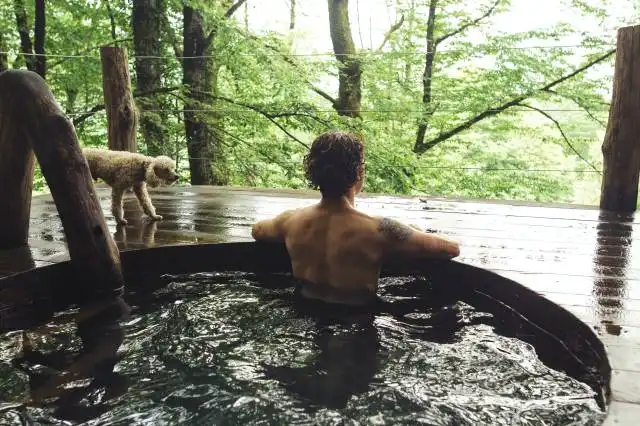Start a Landscape Design Business
Transforming Barren Backyards into Mini-Paradises: The Power of Landscaping Design
| Updated


LANDSCAPE DESIGN BUSINESS
A landscape design business is an engaging venture that combines art, function and our humble appreciation for nature. Imagine turning barren backyards into lush mini-paradises brimming with colors, textures, and tranquility - that's the power you wield as a landscape designer! While your canvas is mother nature herself, your mission is to help homeowners create outdoor spaces that reflect both their personality and the natural world's majesty. This business revolves around designing, planning and sometimes implementing visually pleasing outdoor spaces for clients.
Jump to Business Plan
RELATED BUSINESS IDEAS
Browse ALL Home Improvement & Repair Solutions Business Ideas
Discover Your Perfect Domain
Unlock the door to your online success with our hand-picked selection of premium domain names. Whether you're starting a new venture or rebranding an existing one, the right domain can set the tone for your digital presence. Browse through our curated list, each with its unique potential to enhance your brand's visibility and credibility.
LANDSCAPE DESIGN MINI BUSINESS PLAN
This a quick reality check to help you identify the strengths and weaknesses of your business concept before you dive in.
Business Idea: Landscape Design Business
Expected Percent Margin:
- Gross Margin: 70-80%
- Net Profit Margin: 20-30%
Earnings Expectations:
- Daily Earnings: $250 - $600
- Weekly Earnings: $1,750 - $4,200
- Monthly Earnings: $7,500 - $18,000
- Annual Earnings: $90,000 - $216,000
Actions to Hit Those Numbers:
Professionalism and Expertise:
- Skills and Education: Continuous learning about the latest trends in landscape design and the most effective techniques.
- Certifications: Possess or pursue relevant certifications; for instance, a Landscape Architecture certification.
Marketing and Customer Acquisition:
- Portfolio: Maintain an up-to-date digital portfolio of your projects with professional photos and comprehensive descriptions.
- Network: Actively participate in industry events and engage with prospective clients, suppliers, and other industry professionals.
- Advertisement: Invest in both online and traditional advertisement methods targeting homeowners in the region, ideally between 5%-10% of your projected gross revenue.
Project Management and Execution:
- Staffing: Hire skilled labor team members or establish reliable contract relationships to ensure project delivery timelines and quality.
- Tools and Equipment: Invest in high-quality manual and power tools such as hammers, saws, and digging tools. Also, consider having access to heavy machinery for larger projects.
- Materials: Establish a solid supply chain for necessary raw materials like plants, seeds, soil, and decorative items.
Cost Control:
- Operational Expenses: Work to keep operational costs, including wages, equipment costs, marketing, and insurance, below 30% of your total revenue.
- Negotiate with Suppliers: Build strong relationships with suppliers to negotiate reduced cost for bulk orders.
Business Operations:
- Client Meetings: Engage with new clients daily to understand their landscape needs and preferences, and craft unique designs.
- Project Quantity: Aim to handle 5-10 medium-scale projects per month, adjusting as you scale operations.
- Pricing: Set competitive pricing for your projects based on local market rates, the scale of the project, and the uniqueness of the design.
Again, these are estimated figures and can vary widely depending on the location, economic conditions, and your individual business strategy. Please consult with a business or financial advisor for personalized advice.
NOT WHAT YOU HAD IN MIND? Here are more ideas



Browse ALL Home Improvement & Repair Solutions Business Ideas
Grab Your Business Website Name
Before you get caught up in the whirlwind of setting up your business, invest in a domain name. It's a small but significant step that lays the foundation for your brand and makes it easier for customers to find and trust you. Just like you wouldn't build a house without securing the land first, don't build a business without securing your domain name.
"Why? Can't that wait?" Here's why it shouldn't
Step 1: Determine if the Business is Right for You
Breakdown of Startup Expenses
Starting a landscape design business requires a significant investment of both time and money. It is important to understand the startup costs associated with the business before committing to the endeavor. These costs may include the cost of materials, equipment, and labor. Additionally, you may need to pay for permits, licenses, and insurance. It is important to research the costs associated with starting a business in your area and to create a budget for the startup costs.
Breakdown of Ongoing Expenses
In addition to the startup costs, there are ongoing expenses associated with running a landscape design business. These expenses may include the cost of materials, equipment, and labor. Additionally, you may need to pay for permits, licenses, and insurance. It is important to research the costs associated with running a business in your area and to create a budget for the ongoing expenses.
Examples of Ways to Make Money
There are many ways to make money in the landscape design business. You can offer services such as landscape design, installation, and maintenance. Additionally, you can offer products such as plants, trees, and other materials. You can also offer classes or workshops on landscape design. Additionally, you can offer consulting services to help clients with their landscape design projects. Finally, you can partner with other businesses to offer additional services or products.
Step 2: Name the Business
When it comes to naming a business, it is important to choose a name that is memorable, unique, and reflects the services offered. It should also be easy to pronounce and spell. Additionally, it is important to research the name to make sure it is not already in use by another business. It is also important to consider the domain name associated with the business name, as this will be used for the website and email address. Consider using a domain name that is the same as the business name to make it easier for customers to find the business online. Additionally, it is important to check with the local government to make sure the name is available for use. Finally, it is important to register the business name with the appropriate government agencies to protect the business from any potential legal issues.
Step 3: Create a Business Plan
Creating a business plan is an important step in starting a landscape design business. The plan should include an executive summary, a description of the services offered, a market analysis, a description of the business’s competitive advantages, a description of the business’s organizational structure, a description of the business’s financial plan, and a description of the business’s marketing plan.
The executive summary should provide an overview of the business, its goals, and its competitive advantages. It should also include a brief description of the services offered and a summary of the financial projections.
The description of services offered should include a list of the services provided, the target market for those services, and the pricing structure for those services.
The market analysis should include an overview of the landscape design industry, an analysis of the target market, and an analysis of the competitive landscape.
The description of the business’s competitive advantages should include a list of the business’s unique selling points, such as specialized services or unique technology.
The description of the business’s organizational structure should include a description of the roles and responsibilities of each team member, as well as a description of the business’s management structure.
The description of the business’s financial plan should include a breakdown of startup costs, ongoing costs, and potential sources of revenue. It should also include a financial projection for the first three years of the business.
The description of the business’s marketing plan should include a description of the marketing strategies that will be used to reach the target market, as well as a description of the budget for marketing activities.
Step 4: Obtain Licenses and Permits
In order to start a landscape design business, it is important to obtain the necessary licenses and permits. Depending on the state, this may include a business license, a contractor’s license, and a landscaping license. Additionally, a permit may be required to use certain chemicals or fertilizers, or to operate heavy machinery. It is important to research the specific requirements in the state in which the business will be located.
How to Obtain Licenses and Permits
The process for obtaining licenses and permits will vary depending on the state. Generally, the business owner will need to fill out an application and submit it to the appropriate agency. In some cases, the business owner may need to provide proof of insurance, proof of education, or a criminal background check. Additionally, the business owner may need to pay a fee in order to obtain the license or permit.
Cost of Licenses and Permits
The cost of licenses and permits will vary depending on the state and the type of license or permit needed. Generally, the cost of a business license or contractor’s license will be relatively low. However, the cost of a landscaping license may be higher, and the cost of a permit to use certain chemicals or operate heavy machinery may also be higher.
Benefits of Obtaining Licenses and Permits
Obtaining the necessary licenses and permits is important for a landscape design business. Having the proper licenses and permits will demonstrate to potential customers that the business is legitimate and trustworthy. Additionally, having the proper licenses and permits may be required in order to bid on certain jobs. Finally, having the proper licenses and permits may help protect the business from legal action if something goes wrong.
Step 5: Set Up a Business Bank Account
Choosing the right bank is an important part of setting up a business bank account. When selecting a bank, consider the fees associated with the account, the customer service, and the convenience of the location. Additionally, research the bank’s online banking options, as this can help streamline business operations. Consider the types of accounts available and whether they offer special services such as merchant accounts, payroll services, and business loans.
Setting Up the Account
Once you have chosen the right bank, it is time to set up the business bank account. You will need to provide the bank with your business’s name, address, and contact information. Additionally, you will need to provide proof of your business’s legal status, such as a business license or articles of incorporation. You will also need to provide the bank with a copy of your driver’s license or other form of identification. Once the account is set up, you will be able to access the funds in the account through online banking, checks, and debit cards.
Benefits of a Business Bank Account
Having a separate business bank account is important for tracking business expenses and income. It also helps to keep personal and business finances separate, which is important for tax purposes. Additionally, having a business bank account can help to establish credibility with customers and vendors. Finally, having a business bank account can make it easier to apply for business loans and other financing options.
Step 6: Market Your Business
The sixth step in starting a landscape design business is to market your business. There are a variety of ways to market your business, including traditional methods such as print ads, radio, and television, as well as digital methods such as social media, email campaigns, and search engine optimization. It is important to find the right mix of methods that will work best for your business. For instance, if you are targeting a local market, print ads in local newspapers and radio spots might be the best way to reach your target audience. On the other hand, if you are targeting a more global market, digital methods such as search engine optimization, email campaigns, and social media might be more effective.
Developing a Brand
In addition to marketing your business, it is important to develop a brand for your business. This includes creating a logo, website, and other materials that will help to differentiate your business from the competition. It is important to create a brand that is unique and memorable, as this will help to attract customers and create a lasting impression. Additionally, it is important to ensure that your brand is consistent across all of your marketing materials, as this will help to create a sense of familiarity and trust with your customers.
Networking
Networking is another important aspect of marketing your business. This includes attending local events, joining local business associations, and connecting with other landscape design professionals. This will help to spread the word about your business and create relationships with potential customers. Additionally, networking can help to create strategic partnerships with other businesses, which can lead to more business opportunities.
Online Presence
Finally, it is important to create an online presence for your business. This includes creating a website, setting up social media accounts, and optimizing your website for search engines. This will help to increase your visibility and reach potential customers. Additionally, it is important to ensure that your website is up-to-date and provides customers with the information they need to make an informed decision about your services.
Step 7: Establish a Pricing Structure
When establishing a pricing structure for a landscape design business, it is important to consider the cost of materials, labor, and overhead. Additionally, it is important to consider the local market and the competition. It is important to make sure that the prices are competitive, but also that they are high enough to cover all costs and generate a profit.
Ways to Establish Prices
When establishing prices, it is important to keep in mind the cost of materials, labor, and overhead. It is also important to consider the local market and the competition. One way to establish prices is to research the prices of competitors and use them as a guide. Additionally, it is important to consider the quality of the services being offered and the value they provide. For example, if the services being offered are of a higher quality than the competition, the prices should reflect that.
Examples of Pricing Structures
One example of a pricing structure is a flat rate for each project. This means that the customer pays a set fee for the entire project regardless of the amount of labor or materials needed. Another example of a pricing structure is an hourly rate. This means that the customer pays an hourly rate for the labor and materials used for the project. Additionally, some businesses may offer a combination of both flat rates and hourly rates.
Benefits of Establishing a Pricing Structure
Establishing a pricing structure for a landscape design business has many benefits. It helps to ensure that the customer is aware of the cost of the project before it begins. Additionally, it helps to ensure that the business is making a profit on each project. It also helps to ensure that the customer is aware of the value of the services being provided and the quality of the work being done. Finally, it helps to ensure that the business is competitive in the local market.
Step 8: Secure Insurance
Securing the right insurance for your business is essential for protecting your assets. Depending on the type of business you are running, you may need general liability insurance, professional liability insurance, workers' compensation insurance, or a combination of all three. General liability insurance will protect you from any claims of negligence or injury, professional liability insurance will protect you from any claims of malpractice, and workers' compensation insurance will protect you from any claims of injury or illness that occur on the job.
How to Find the Right Insurance
Finding the right insurance for your business can be a daunting task. Start by researching different insurance companies and comparing their rates and coverage. You can also speak to other business owners in the same industry to get their advice on which insurance companies they use. Additionally, you can consult with an insurance broker who can help you find the right insurance for your business.
Cost of Insurance
The cost of insurance will depend on the type of business you are running and the coverage you need. Generally, general liability insurance will cost around $500 to $1,000 per year, professional liability insurance will cost around $1,000 to $2,000 per year, and workers' compensation insurance will cost around $1,000 to $2,000 per year. However, these costs can vary depending on the type of business you are running and the coverage you need.
How to Save Money on Insurance
There are a few ways to save money on insurance for your business. One way is to shop around and compare rates from different insurance companies. Another way is to bundle your policies, which can help you save money on premiums. Additionally, you can look for discounts, such as multi-policy discounts, loyalty discounts, and discounts for paying your premiums in full.
Step 9: Hire Employees
When hiring employees for a landscape design business, it is important to consider the skills and experience of the potential hires. It is also important to consider the cost of hiring and the amount of time it will take to train the new employees. Additionally, it is important to consider the local labor laws and regulations that may affect the hiring process. It is also important to consider the employee benefits that will be offered and the cost associated with them. Finally, it is important to create a job description for each position that outlines the duties and responsibilities of the employee.
Benefits of Hiring Employees
Hiring employees can be beneficial to a landscape design business in many ways. Employees can help with the day-to-day operations of the business, such as customer service, design, and installation. Additionally, employees can help to expand the services offered by the business and can help to increase the customer base. Furthermore, having employees can help to reduce the workload of the business owner and can help to free up time for other tasks. Finally, having employees can help to create a more professional and organized business.
EXPLORE MORE CATEGORIES
Browse ALL Business Idea Categories
TAKE THE NEXT STEPS










